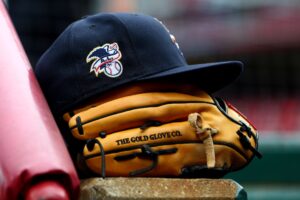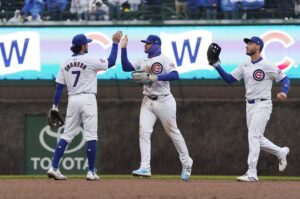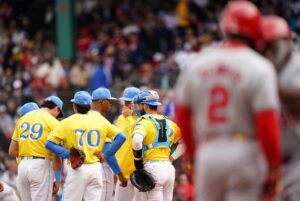The year is 2013. The Atlanta Braves have just captured their first NL East title since 2005 and are returning to the postseason for back-to-back seasons. The team boasts a strong core of players still in their 20’s. Even more, Atlanta has clinched home-field advantage against the Los Angeles Dodgers. For the first time since the late 90s and early 2000s, Atlanta has serious World Series aspirations. What could possibly go wrong?
What did go wrong was the 2013 NLDS. Atlanta was shutdown by Clayton Kershaw in Game 1 and squandered a golden opportunity in Game 4 via a blown lead to lose the series three games to one. Questionable decision making plagued the team in that series. However, there were some moments and factors from the regular season that played a role in Atlanta’s eventual defeat.
What Could Have Been – The 2013 Atlanta Braves Season
The Good
A power-packed lineup
The 2013 Braves were swinging for the fences before it became a league-wide trend. Atlanta led the National League in home runs, hitting 181 of them, and finished fourth in the NL in total runs scored. They were one of just two NL teams (Chicago Cubs the other) to finish in the top 10 of MLB teams for home runs. The Braves also did this while tying the New York Mets for the NL lead in strikeouts.
Atlanta boasted a formidable offense in 2013, and the team appeared destined for big things well into the future. The Braves had five players 26 years old or younger who hit at least 14 home runs. Additionally, just one position player to appear in 90 or more games was over 30. 2013 was shaping up to be the beginning of greater things still to come.
A solid rotation
Atlanta’s rotation was headlined by Mike Minor, Kris Medlen, and Julio Teheran heading into the postseason. Each of these players made at least 30 starts and threw at least 185 innings with a 3.21 ERA or better and 157 strikeouts. Alex Wood also assisted in the rotation and pitched well in 11 starts over the course of the season.
The pitcher missing from the list above is Tim Hudson. At 37 years old, Hudson continued to perform at a high level. His 3.97 ERA through 21 starts does not tell the fully story. His FIP, home run rate, walk rate, and strike out rate were all much closer to Medlen’s numbers, and he was slowly but surely lowering his ERA from the 5.37 number he carried on May 27. Unfortunately, he made his last start of the season on July 24 and missed the postseason. More on that later.
A lights-out bullpen
The bullpen was anchored by one of the best closers in all of baseball in Craig Kimbrel. He converted 50 of 54 save opportunities with a 1.21 ERA and 98 strikeouts in 67 innings pitched. Unfortunately, he only received one save opportunity in the NLDS. In fact, the biggest memory many Braves fans have of Kimbrel from that series does not involve the closer pitching. Again, more on that later.
The bullpen was rounded out by Luis Avilan and David Carpenter, with both relievers appearing in at least 56 games with a sub-2.00 ERA. Anthony Varvaro, Luis Ayala, Jordan Walden, Eric O’Flaherty, and Scott Downs also pitched well in spurts for arguably the best bullpen in baseball during 2013. With a solid rotation, a complementary and dominant bullpen, and a powerful lineup, Atlanta was seemingly one of the most complete teams in baseball.
The Bad
Despite Atlanta’s impressive top-to-bottom lineup, there were some holes on the team. It just so happened the two biggest holes were also the two highest-paid players on the roster. Dan Uggla did hit 22 home runs, but his power all but disappeared in the second half. With no more power, a .179 batting average, and a questionable glove, the Braves decided to leave the second baseman off the postseason roster. Melvin Upton Jr. (still going by B.J. at the time) was left on the roster for the NLDS, but he was mainly serving as a fourth OF. His own offensive struggles led the team to play Jason Heyward in CF and hard-hitting Evan Gattis in LF. Still, even with their limitations and struggles, the Braves should have possessed enough firepower to compete well into October. As it turns out, there were two key moments in the season that changed everything.
Deciding Moments
Tim Hudson suffers a broken ankle
The night is July 24, and the Braves are squaring off against their division rivals, the New York Mets. The 37-year-old veteran. known as “Huddy”, is in the middle of another one of his vintage starts. It is the eighth inning, but he has yet to allow a run while striking out nine batters. In fact, Hudson is in his fourth-straight start of at least seven innings pitched, and his eighth out of his last 10 outings after a rough start to the year.
With two runners on and OF Eric Young Jr. batting, Hudson stretches and delivers. Young hits a hard ground ball that takes a tricky hop off the chest of Freddie Freeman at first. Young is hustling down the line, but Freeman recovers and throws to Hudson covering at first. Young is out by a long step at first, but something is clearly wrong as Hudson lays face down in the grass.
A replay clearly shows the scary incident. While trying to blindly find the bag, Hudson had placed his right foot dangerously close to the outside corner of the bag. Young, hustling down the line to beat out the throw, accidentally stepped squarely on Hudson’s ankle.
Young came back to check on Hudson, clearly distraught, but the damage had been done. A broken ankle was soon confirmed, ending Hudson’s season. Would Hudson make a difference if able to pitch in the NLDS? We will never know, but he definitely would have improved Atlanta’s chances.
Atlanta keeps Kimbrel on the bench in Game 4
To say the Braves were in a tough spot heading into Game 4 of the NLDS would be an understatement. The Dodgers were sending Kershaw to the mound on short rest, hoping to end the series early. In response, the Braves sent 36-year old journeyman Freddy Garcia to the mound. Somehow, he did the job. Atlanta scraped together three runs while Garcia limited Los Angeles to two over six innings. That’s how the score stood headed to the bottom of the eighth.
In a one-run game, manager Fredi Gonzalez went with Atlanta’s setup man in Carpenter. While he did not pitch in Game 3 and was well-rested, many fans wanted to see Kimbrel right away. Carpenter had also struggled in Game 2 of the series, giving up two runs on a home run to Hanley Ramirez. Unfortunately, fans never got to see Kimbrel pitch at all that night. Carpenter gave up a leadoff double before surrendering the go-ahead home run to Juan Uribe.
Gonzalez stood by his decision after the game, claiming he was ready to use Kimbrel for four outs and not six, but his reasoning and decision-making were confusing. The Braves held a slim, one-run lead in a do-or-die game. In the playoffs, you use everything you have. You certainly do not let the best reliever in the game sit on the bench. The only play Gonzalez had was to use Kimbrel to start the eighth, and then take it one step at a time. Instead, Atlanta went home, began rebuilding one year later, and Gonzalez was eventually fired.
Conclusion
So, would the NLDS, and the 2013 postseason, have played out differently if Hudson were still healthy? Would Kimbrel have slammed the door shut on the Dodgers and forced a Game 5 in Atlanta? Fans will never know, but missing the leader of their rotation and not using their best reliever with the season literally hanging in the balance left a sour taste with many fans and players. Baseball marches on, and we will just have to wonder what could have been for the 2013 Braves.
Main Photo:
Embed from Getty Images






